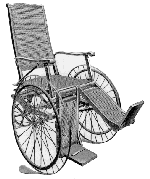A Historical Sociology Of The Wheelchair
Abstract
For millions of disabled people the single most important technological innovation of the 20th century has been the modern wheelchair. Yet, in common with most technologies for disabled people, there has been little sociological analysis of this machine. Through a combination of oral accounts and archival sources this project will construct a historical sociology of the wheelchair in the 20th century. By bringing together disability studies and the sociology of science and technology, this study will examine the underlying processes in wheelchair design; explore the ways that the wheelchair has constructed and transformed self, identity and the meaning of disability; and investigate lay and expert contributions to wheelchair innovation. Our inquiry into how this machine has developed will make a valuable contribution to an understanding of the multidimensional nature of the relationship between the creators and users of technologies for disabled people.
Summary
Background
For millions of disabled people the most important technological innovation of the 20th century was the modern wheelchair. The bath chair, or "invalid chair" that dominated the late 19th century was a heavy, cumbersome machine designed to be pushed by an attendant rather than controlled by the occupant. The idea that a wheelchair user could be active was never considered. Since then, the wheelchair has developed into a powerful tool and those that dominated at the end of the 20th century were built with the occupant in mind. Indeed, the design emphasis and marketing strategies of the modern wheelchair were centred on the machine's capacity to deliver greater independence for the user. This is a significant change. In parallel, the move towards the greater social inclusion of disabled people, an outcome of their struggles for independence, changed both the meaning of disability and the personal consequences on individual lives of being a disabled person. Yet, there is little social or historical analysis that details the relations between these currents of social and technological change. Our research will fill this gap.
Research Design
Our sociotechnical history will be built upon a combination of in-depth interviews and archival research conducted in both the UK and the US. Interviews will be conducted with around 100 key participants in the wheelchair's development. Our approach will be purposive sampling, so we will deliberately seek to interview those who have played an important role in the development of the wheelchair, or who are particularly well-placed observers of that development. Archival sources will come from rehabilitation units, disability organisations, medical and governmental libraries and Patent Offices. Technical-scientific publications, such as journals, conference proceedings and company reports will also provide a rich source of technological and scientific detail, albeit often in abstraction from context. Reviews of journals such as Paraplegia, will allow us to map the generation, growth and changing nature of knowledge and practice in particular fields. Disability groups' publications, such as Paraplegia News, are another valuable sources of data that will chart the relations between wheelchair users and other actors in the wheelchairs history.
Policy and Academic Implications
In the construction of our sociotechnical history of the wheelchair we
will bring together the knowledge and skills of two diverse fields of study:
disability studies and the sociology of science and technology. Our research
will generate new theoretical ideas about the relationships between technology
and disability; and produce a valuable analysis of the little explored field
of technologies for disabled people. At a policy level, this work will inform
those who create and provide wheelchairs of the implications of this product
and thus be more receptive to the complexities of users relations with their
wheelchairs.
In line with the programme's objectives, this research will also enable
us to: (i) assess the distribution and re-distribution of power between
"experts," professionals, amateurs and lay peoples through an
exploration of the changing roles of each in the evolution of the wheelchair;
(ii) examine the ways the wheelchair has constructed and transformed concepts
of self, identity and the meaning of disability; and (iii) investigate how
changes in wheelchair design have reflected and/or contributed to changing
patterns of social exclusion and inclusion. Thus, the inquiry will open
the way for a reappraisal of some fundamental concepts, namely: the relationship
between technology and independence, the complex relations between the creators
and users of technologies, and the impact of wider socio-cultural factors
on the development and acceptance of technologies.
Contacts
Dr Brian Woods
Professor Donald Mackenzie
Dr Nick Watson
Outputs
Publications
Brian Woods and Nick Watson, (2004) ‘In Pursuit of Standardization: The British Ministry of Health’s Model 8F Wheelchair 1948-1962,’ Technology and Culture, 45, 3: 540-568
Brian Woods and Nick Watson, (2004) ‘A Glimpse at the Social and Technological History of Wheelchairs,’ International Journal of Therapy and Rehabilitation, 11, 9: 407-410
Nick Watson and Brian Woods, (forthcoming) ‘No Wheelchairs beyond
this point: A historical examination of wheelchair access in the Twentieth
Century in Britain and America’ Social Policy & Society (in press)
Brian Woods & Nick Watson (2003) 'A Short History of Powered Wheelchairs,'
Assistive Technology, 15 (2): 164-180.
Brian Woods and Nick Watson, (forthcoming) 'When Wheelchair Innovation in Britain was Under State Control,' Technology and Disability
Other
Nick Watson radio interviewe by NSK, the Norwegian equivalent of Radio 4, about 'The Cultural and Political History of the Wheelchair' - see conference papers below
Brian Woods and Nick Watson, (2002) 'Missing Histories: The Development of the Wheelchair during the 20th Century,' BON Issue 26: 50 (Newsletter of the British Orthopaedic Association).
Brian Woods and Nick Watson, 'Towards a History of the Wheelchair,' published in:
- The Bulletin (Newsletter of the British Polio Fellowship), March 2002: 13
- Disability Times, October 2001: 8
- Blesmag, (Magazine of the British Limbless Ex-Service Men's Association) Summer 2001: 8-9
Conference Papers
Nick Watson 'The Cultural and Political History of the Wheelchair' keynote
address to the Nordic Network of Disability Research. April 2005
Brian Woods, (oral) "Elements of Wheelchair History," Technology and the Body, the Canada Science and Technology Museum Ottawa, Canada on 4-6 November 2004
Brian Woods and Nick Watson, (oral) "Disconnected Technologies: tensions
between the medicalization and the politicization of wheelchairs during
the 20th century," a symposium on the history of disability, the Centre
for the History of Science, Technology and Medicine, University of Manchester,
28th October 2004
Brian Woods and Nick Watson, ‘Wheelchairs as Political Machines,’ Healthy Innovation Workshop, University of Manchester, 8-10 July 2004.
Brian Woods, Nick Watson & Donald MacKenzie, ‘A Historical Sociology of the Wheelchair,’ poster presentation at the first Hull, York Medical School Research Conference, Ramada Jarvis Hotel, Willerby, 11 February 2004.
Nick Watson, 'No Wheelchairs Beyond This Point: a post-war history of wheelchair
access in Britain and America'
Disabled people and social justice. Conference to mark European Year of
Disabled People 2003
Friday 14 November 2003, The Lighthouse, Mitchell Street, Glasgow
programme - pdf
Nick Watson and Brian Woods, 'Sitting at the Table Doesn't Necessarily Make You a Diner: A Historical Analysis of Special Seating in Wheelchairs,' Medical Sociology Group Annual Conference, University of York, 26 - 28 September 2003.
Brian Woods and Nick Watson, 'Power to Independence,' Inaugural Conference of the Disability Studies Association. Disability Studies: Theory, Policy and Practice, Lancaster University, 4 September - 6 September 2003.
Brian Woods, 'Disability, Design and Community Service: Lessons from the Wheelchair,' ESRC Research at York: Implications for Future Regional Needs, 23 June 2003, Priory Street Centre, York.
Brian Woods and Nick Watson, 'Wheelchair innovation under state control: a historical glance,' Centre of Rehabilitation Engineering, Kings College London Conference, 'Recent Advances in Assistive Technology and Engineering,' Birmingham Botanical Gardens, 18-19 November 2002.
Brian Woods, 'A Concise History of the Wheelchair Under the British State,' The Society for the History of Technology, Annual Meeting, Delta Chelsea Hotel, Toronto, Canada, 2002 October 17-20.
Brian Woods and Nick Watson, 'Towards a Sociology of the Wheelchair,' Invited Lecture at the School of Disability Studies, Ryerson University, Toronto, Canada, 17 October 2002. http://www.ryerson.ca/ds/RBCResearch_Unexpected.htm#wheelchair
Brian Woods and Nick Watson, 'Accountability, Wheelchair Design and the British State,' European Association for the Study of Science and Technology, 'Responsibility Under Uncertainty: Science, Technology and Accountability,' 31 July - 3 August 2002, University of York.
Brian Woods and Nick Watson, 'Towards a Sociology of the Wheelchair,' British Sociological Association Annual Conference, 'Reshaping the Social,' 25-27 March 2002, Leicester University.
Miscellaneous
The BBC children's programme Blue Peter approached the research team for advice on the history of the wheelchair for a programme aired on 02/06/03.
Happy Ever Afters: a storybook guide to teaching children about disability approached the research team for advice on aspects of wheelchair history.
News
Conference Report: Disabled People and Social Justice, 14 November 2003,
The Lighthouse, Glasgow
http://www.scrsj.ac.uk/Disability/
Dr Brian Woods. Science and Technology Studies Unit, The University of
York, has had the following abstract accepted at the Society for the History
of Technology for their conference in October, Toronto, Canada.
A Concise History of the Wheelchair Under the British State
Prior to 1948, most disabled people had to look to the private market for wheelchairs or rely on charitable gifts and donations. With the advent of the National Health Service, however, the British State assumed responsibility for the supply, distribution and development of wheelchairs. Hence, the British State not only altered fundamentally the market for wheelchairs in the United Kingdom, it extended its reach deep into the technical detail of wheelchair design. This centralized approach continued until the establishment in 1987 of the Disablement Services Authority, which oversaw the relinquishment of state control over the design and development of wheelchairs and the devolution of wheelchair provision to individual NHS Trusts.
During those 39 years, the great mass of the state pulled towards it practically everything to do with wheelchairs: who received a wheelchair, which firms manufactured them, the types of wheelchairs that were available, indeed the very makeup of wheelchairs and the direction and pace of wheelchair innovation were all largely determined by the actions of the state. In the years after the establishment of the NHS, the Ministry chair (a term that was commonly applied to the various models supplied by the state) dominated the UK wheelchair market. The most pervasive, the Ministry Model 8, which by the early 1960s accounted for over 95 per cent of all prescription wheelchairs has, since its introduction in 1951, shaped the British understanding of what a wheelchair is.
Nevertheless, as influential as the state was, it would be wrong to endow it with omnipotence. It would also be wrong to understand the wheelchair as a homogeneous entity. Technologies and the forces that create and sustain them are constructed from heterogeneous elements. What the wheelchair is (even the technical "facts" about its workings) and how it came to be are determined by a multiplicity of social as well as technical actors.
The objectives of this paper are: to provide an overview of the wheelchair's
history under the British State; to explore the different interests that
surrounded the development and use of this technology; to show how periods
of stabilisation were achieved, maintained and then re-determined; and to
survey the different meanings that were given to the Ministry wheelchair
by the various social groups involved in its story. Through the reconstruction
of this sociotechnical history, I will draw on two diverse fields of study:
disability studies and the sociology of science and technology to generate
some new ideas about the relationships between technology and disability
and produce a valuable analysis of the little explored field of technologies
for disabled people.

